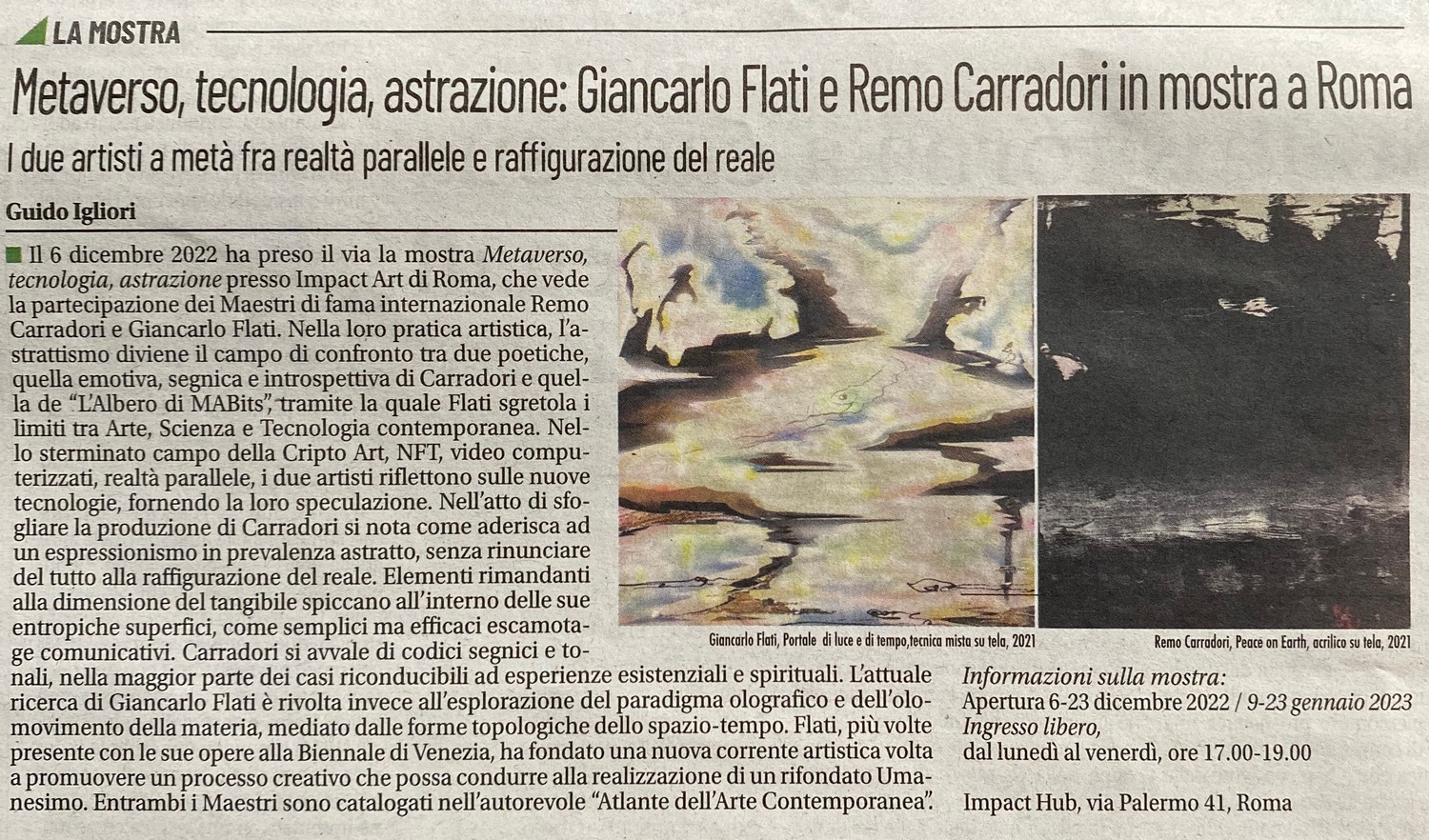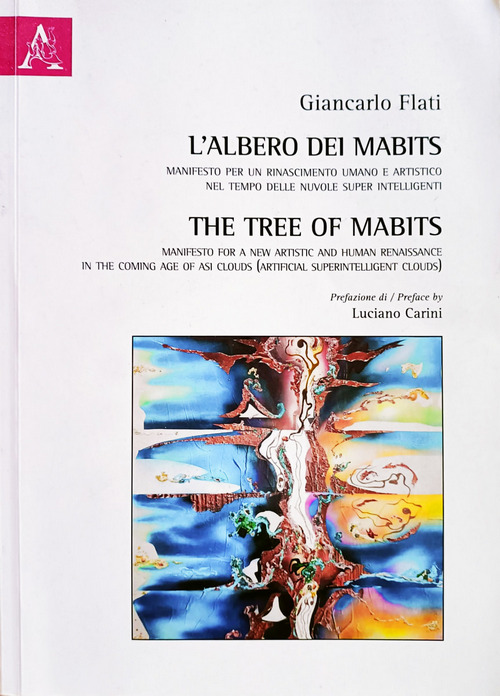
Summary
After the success of his latest essay published with Aracne Ed. The secret of Bentov’s Pendulum. Co–science Aesthetic of the Invisible and Hidden Orders, Giancarlo Flati is publishing again his recent assay The Tree of MABits with Aracne Ed. This Manifesto has been conceived as a theoretical foundation and inspiration for the constitution of a creative movement aimed at promoting a new artistic Renaissance and a new Humanism. The Art of Flati wants to be a tenacious and conscious reaction to the tsunami that recently hit the entire planet. This book was born as a need for redemption and rebirth from the sufferings and darkness fallen on men by the recent Coronavirus Pandemic. The Manifesto is an opportunity to prepare the creative mind for the immense challenges of the third millennium. In Flati’s vision, this ambitious project will only be possible thanks to the healthy alliance between Art Science and Technology.
«From these premises, therefore, — Luciano Carini writes in his preface — the Manifesto of Giancarlo Flati was born and comes to life, a manifesto I strongly encouraged and supported for its evident artistic and philosophical innovations, for its innovative and revolutionary contents, for its ability to be rooted in the present, but also to be able to project, with wise intelligence, into the future, beyond the borders of our complex and troubled days. Giancarlo Flati is therefore a frontier artist, operator and scholar of Margins and Borders because he is active in that subtle and indefinite area where matter meets mind and fantasy, art with science, the visible with the invisible, the concrete with the abstract. And here I like to remember his work, already presented at the 57th Venice Biennale of Art, of the tree of the Margins or the tree of MABits, an emblematic image, symbol and metaphor of time, with the strong hope that it will become the tree of the art of the future, which will eventually grow producing new fruits, new and different languages, new beauties».
Preface
by Luciano Carini
Giancarlo Flati is a pleasant and profound storyteller, capable, like few others of involving and passionate you with his acute and precise reflections on primordial chaos, origins of life, implicate order and explicate order, relationship between art and science and countless other topics of compelling and extraordinary relevance. A meeting, the one with Giancarlo Flati, which represented for me a real dive into the past, a path backwards in memory. He suddenly brought me back to the seventies when, still very young, I spent my summers in Gropparello (Piacenza), in the company of Ernesto Treccani, Bruno Cassinari, Ennio Morlotti, Luciano Minguzzi and various other great artists linked or founders of the Corrente Group.
I remember, as if it were now, the long hours spent debating on art and its function, on the relationship between art and society, art and politics. Discussions today outdated and faded, but then new and current, children of their time. The questions and issues that Giancarlo Flati puts to our attention today are quite different. Artist, surgeon, teacher and researcher, for some time now he has been deeply engaged in a research that, with courage and determination, but also and above all with originality and creative freshness, falls into the maze of science, geometry and topology in an analytical complexity that includes space and time, physical and mental matter, thought and invention.
We are living in complex times, characterized by strong and sometimes sudden changes, by epochal changes and by great and unexpected scientific discoveries that, in some way, come to modify our way of being in the universe. Just think of powerful accelerators of particles which aim is to reconstruct in detail the complicated mechanisms that gave origin and shape to the world in which we live or to artificial intelligence, to the algorithm that governs our daily learning. In short, science incessantly proceeds and with it changes the way we see and tell the world. This not only for the new tools and technologies that arise, but also, and above all, because, by changing the paradigms, all our relationships are changed.
When we look at our world with different eyes and perspectives, our culture, art, philosophy, the proper way of understanding and conceiving life and existence also changes. Therefore knowing and anticipating these changes means gaining the resources to build a better and more advanced society. For all these reasons, today art, science and philosophy are still important and fundamental instruments and disciplines, because they give meaning and consistency to our existence. This unitary vision of the world, which arises and develops from our most distant past, is, still today, the most suitable tool to face the challenges of tomorrow.
Based on these premises the Manifesto of Giancarlo Flati was born and comes to life, a Manifesto I strongly encouraged and supported for its evident artistic and philosophical innovations, for its innovative and revolutionary contents, for its ability to be rooted in the present, but also to be able to project, with wise intelligence, into the future, beyond the borders of our complex and troubled days.
Giancarlo Flati is a frontier artist, operator and scholar of Margins and Borders because he is active in that subtle and indefinite area where matter meets with mind and fantasy, art with science, visible with invisible and concrete, and the abstract. I like to recall his creation, already presented at the 57th Venice Biennale of Art, the tree of the Margins or the tree of MABits, an emblematic image, symbol and metaphor of time, with the strong hope that it will become the tree of the art of future, which can sprout and produce new fruits, new and different languages, new beauties.
Overall, Giancarlo Flati’s Movement proposes and develops an active and fruitful cultural alliance between art, science and technology in order to move the perceptive abilities, mental archetypes and creative consciences of each of us. But how to translate all this to the artistic and aesthetic level? In this context the expressive skill of Giancarlo Flati is interesting and engaging.
His research path, figurative in origin, came gradually to the Informal and then to the current expression very close to the Conceptual, but with highly original characteristics and solutions of the whole. Thus, since the end of the seventies, his language was gradually renewed and enriched starting from the analysis of visual space, structures and methods of pictorial practice which, on several occasions, has widely brought images and elements into play now consolidated in the history of art.
His way of proceeding, his scientific–analytical attitude, however, is not only reduced to a cold and calculated scientific investigation, but opens a new and different operational perspective full of implications and suggestions, especially when the artist, with acumen and intelligence, manages space and represents different worlds, from the micro to the macrocosm in the search of identifying a common root and a common origin. Painting made of quantum fluctuations, of paths, paths and filaments that capture the observer projecting him inside his visual plot and inside the illusory dimension of configurational space in an endless geometric scan. A sign, that of Flati, which does not appear soft and fluid, but rather tormented and fragmented in continuous stratifications, in alternating and intermittent rhythms and then, again, the interweave with various and different materials such as roots, woods, debris, fossils and electronic boards: poetic reference to the past and precious reflection on the present, on a continuously changing reality with its everlasting becoming.
An expression that at times is dressed in luminous and almost transparent lightness, while at other times, in dark and dramatic depth, or eventually in clear and magical cosmic distances that recall infinite and unknown stellar worlds. Amazing are its colors which, with spontaneity and immediacy, pass from the liquid to the material state to make sense of life, the crushing of existence, the unexpected events of mortal destiny. Intense expression, this one by Giancarlo Flati, where the greatness of primitive void always emerges but also, and above all, the amazement and wonder in front of the beauty of the universe. Here is the meaning of this Movement which places hopes for an art capable not only of looking at reality, but of trans–seeing, of seeing beyond trying to grasp, of everything and every phenomenon, all internal and external resonances, temporal and spatial references, environmental and cultural contexts. And his concrete proposal is not so much to create a “New pictorial Current” or to establish a more or less gregarious spirit, but rather to establish, over time, a real free and open Intercultural and Interdisciplinary Laboratory by breaking down the borders or the margins between space and matter, science and art, mind and consciousness, visible and invisible. The final horizon is the Margin of Margins, the extreme border of subtle matter, where everything is light, in suspension, soul and spirit in a true and undisputed territory of art.
And here begins the “Creative Process” suggested and described by Giancarlo Flati and already embodied in the term In–form–action (ideation, formation and action) essential for producing and developing true works of art, “connected” with the outside and the whole world because they are “free” and “autonomous” from the artist who conceived and created them.
In other words, works capable of lasting over time and capable of speaking to future generations in a positive and constructive dialectical relationship with the past in order to add new branches to the “Great Tree of Art and Life”.
Today we must have the courage and strength to promote a NEW ART that knows how to «bring together and evolve, in a harmonious way, men and machines, biospheres and technosphere». All this, in full respect of the diversity and freedom of those who deem it right and appropriate to join this Movement and bring their philosophical thought and creative and expressive contribution to it. And in this regard, the image of the “snowflake” proposed by Giancalo Flati seems to me to be particularly centered. Each artist is like a snowflake, fortunately endowed with his own unique identity. The beauty of the snowflakes is not in their similarity, but in their diversity and in the way they form wonderful landscapes by uniting. Yet their diversity is the result of a certain analogy of their formative processes, each staple follows the same process but in different contexts and initial conditions.
Therefore from what has been described, a strongly contemporary manifesto emerges, being able to enter with authority and competence the paths of science, technology and communication and capable of looking with new and different eyes at the varied world of the Symbolic.
Art rediscovered as indispensable resourse to enter far beyond reality and matter, crossing them with the senses and emotion up to the highest and most permanent levels of knowledge and aesthetic cognition. And, again, a manifesto that manages to pierce that «margin of shadow that accompanies every moment of our existence, the one between visible and invisible, between the illusion of reality and the reality of the virtual, between material and immaterial» bringing out all the beauties hidden by the mists of indifference and the lightness of the common gaze.
Syntetic decalogue of the Manifesto and module of the creative process
1. Foundation and Roots of the Aestethic of Margins.
The movement “The Tree of MABits” (MABits stands for Marginal Art Bits) is based on the Aesthetics of Margins and wants to project its aerial roots into the invisible depths of some margins (Art–Science, Mind–Matter, Mind–Spirit, etc.). In these complex cultural frontiers the roots of our tree are to be imagined as tangling and interacting while absorbing primordial lymph capable of nourishing various aesthetic and creative sensitivities (Spiritual, Materials, Technological). Their contribution of energy, in the “form” of information resources (bits), will prepare our mind for a new creative paradigm, for a new — or profoundly renewed — art, open to the complex challenges of modernity. “Life comes from life,” said Pasteur. We like to think that the roots of our tree are nourished by “Art alive from Life”.
2. International Virtual Laboratory for the Art of the Invisible and Cyber–Clouds.
The movement “The Tree of MABits”, is emerging in the classical pictorial context but wants to be inclusive and open to all the protagonists of the world of Art and Culture: artists, critics, scientists, philosophers and thinkers of Italian nationality and other countries of the World. It will not be a lounge for nostalgic and romantic “bohemians” or “primedonne”, with hat and scarf. Rather, it is intended to be a Think Tank factory for reflective and creative consciences and, at the same time, a “practical and concrete research unit” where hands and clothes are “dirty” with colors and strive for tuning our works with the secrets of the invisible and contemporary cyber–reality.
3. Art Towards the Future.
The movement wants to pursue a cultural alliance between Art, Science and Technology. This should not be intended as a facade alliance but should rather aim at a real evolutionary transition of our perceptive ability, mental archetypes and creative consciousness. We will have to work for an Art that looks to the Future (having in our DNA indelible marks left by the art of the past), capable of renewing itself, drawing vitality and “substance” from a harmonious handling of “information” resources emerging from the most extreme domains of Science, Technology and Aesthetics itself. What will be our destiny as men and sentient beings equipped with a creative “genome” (ARTgenome?) in the incipient realm of Artificial Minds and ASI Clouds (Artificial Super Intelligent Clouds)?
4. Art for a New Humanity.
Promotion of new resilient and homeostatically mature humanity to face the era of Tecno Humanism, Promotion of New Artistic Renaissance.
Could art be helpful for mankind in pursuing the harmonious coexistence of biosphere, technosphere and cybersphere, between the illusion of Eden of the Cyber–optimists and Frankenstein’s terror of the biopurists? It is certainly not the task of art to solve social and political problems but we believe it can, with the lightness that characterizes it, suggest to man the subtle game of “feeling” the charm of a ‘beautiful’ use of knowledge and of exploration of the invisible hidden behind the joys and sorrows of human existence and of the cosmos that hosts us.
5. New Techniques and Languages.
Promotion of new or profoundly renewed techniques and languages.
The implementation of techniques with high expressive efficiency, originality and linguistic elegance aimed at pursuing: beauty, clarity, freshness, vitality, subtle ambiguity, multidimensionality, communicability to the world is encouraged. We will not give up our grains of sand, colored earth, our stones and our dear and old “palette” but we will be continually renewing it, making it permeable to the new “hybrid materials” and technological amplifications, including some of the most innovative Virtual Art Technologies such as, for example, TiltBrush. The technical quality should be in harmonic resonance with the ideational depth and structural solidity of the entire process.
6. Process and Structure of the Creative Module. (Fig. 2)
The triad of the creative process already implicit in the term IN–FORM–ACTION (Fig. 2) ought to be understood by thinking metaphorically of a tree with three main branches and three foliage producing, respectively, “abstract” resources of three types (Qbits, Bits, Ebits), in relation to three different Aesthetic, Mental and Emergency domains (note 4):
a) ideation which draws on the cosmic Mind, the Implicate Order, the Invisible, the Irrepresentable and the Mystery (Phase IN: Qbits);
b) logical and structural “formation” of the idea (FORM phase: Bits);
c) action (means of expression and materials): the main purpose of the Action and executive techniques is to communicate with stylistic consistency and spontaneity the idea that already is an “in progress” structure. The Action is a completion of the in–forming structural tension and inter–relational “passionate” action that co–embodies the Artist, the Work and the user of the work. (ACTION phase: Ebits) (Entangled Bits, note 6). The synthesis of this triad can be expressed with the MABits formula.
7. MABits – Unit of Artistic Information of Margins.
MABits genealogy from the In–Form–Action and the Triadic process of Figure 2.
The term MABits stands for Marginal Art Bits and is the result of a creative equation consisting of three parameters: the Qbits (In phase), the Bits (Form Phase) and the Ebits (Action phase) combined together in two ways. The simplest one (weak emergency) based on the sum of the basic information units (MABits = QBits + Bits + Ebits) and the more expressive one, a Golden equation (strong emergency) based on the multiplicative interaction (Qbits x Bits x Ebits). MABit is proposed as a basic unit of artistic information with an emergential genealogy. To understand the meaning of the MABits basic units and their interactions, let’s take an example: a hyper–realistic work is mainly made of Bits; a spiritual / informal / abstract work is made with a prevalence of Qbits, and a hyper–relational, hyper–imaginative, futuristic, expressionist, passionate and emotional is mainly realized with Ebits. We could also call them Emotional bits, after all the “physical” Entangled Bits were associated by Abner Shimony with “passion at distance”! For example, Michelangelo’s “Last Judgment”, being a strong artistic emergency, is made of MABits emerging from a Golden aesthetic equation.
8. Expressive, Structural Quality and “Spatial” Organization of the Art Work (Perspective Lines, Fields, Colors, Materials, Gestures and Signs) Inspired by the Concepts of Constitutive Absence and Topological Spatial Relationship.
The movement aims to promote the qualitative growth of the execution phase and the structuring of the work.
Having in mind «the doctrine of the extreme beginner» by Luzi, is a precious guide for a correct executive tension and for achieving a continuous improvement of technique and expressive language. Sometimes, in art the less means more and this less is linked to the concept of constitutive absence and relationality of topological spaces (Figg. 10, 11, 12). The constitutive absences and the topological space are perhaps the two most relevant technical–executive aspects of the aesthetics of the margins and of our entire creative process.
9. The Primary and Necessary Objective is the “Connected” Work.
Creating “connected” works.
The spontaneity and dynamism of action, gesture, sign, color and sensitivity for the harmonic hybridization of the materials increases the quality of Technique and invigorates its communicative power and its intimate “connection” with the soul and mind of observers evoking their participation and interaction with the work. The artist should have the courage to destroy a totally disconnected or “dead” work and try again until it reaches the goal. Sometimes before the destruction it is appropriate to quarantine the work for two or three years.
10. Utopic Objective: Autonomy and Durability of Works, Created in Suspension Between History and Destiny.
Among the works created with particular qualitative and structural depth, consistently with the 9 previous indications, only few or perhaps none can aspire to be suitable for breaking the border of the impossible. Creating “autonomous” works intended to last and live over time, is the most ambitious goal of an artist. The artworks ought to be able to ‘speak’ to the future of the world and future generations. They ought to be resembling a poem in silent communication with the reader’s heart of any place and time. Although it may seem too ambitious, it is still worth being pursued with the same tenacity that leads a marathon runner to engage in hard training in order to win an Olympic game.
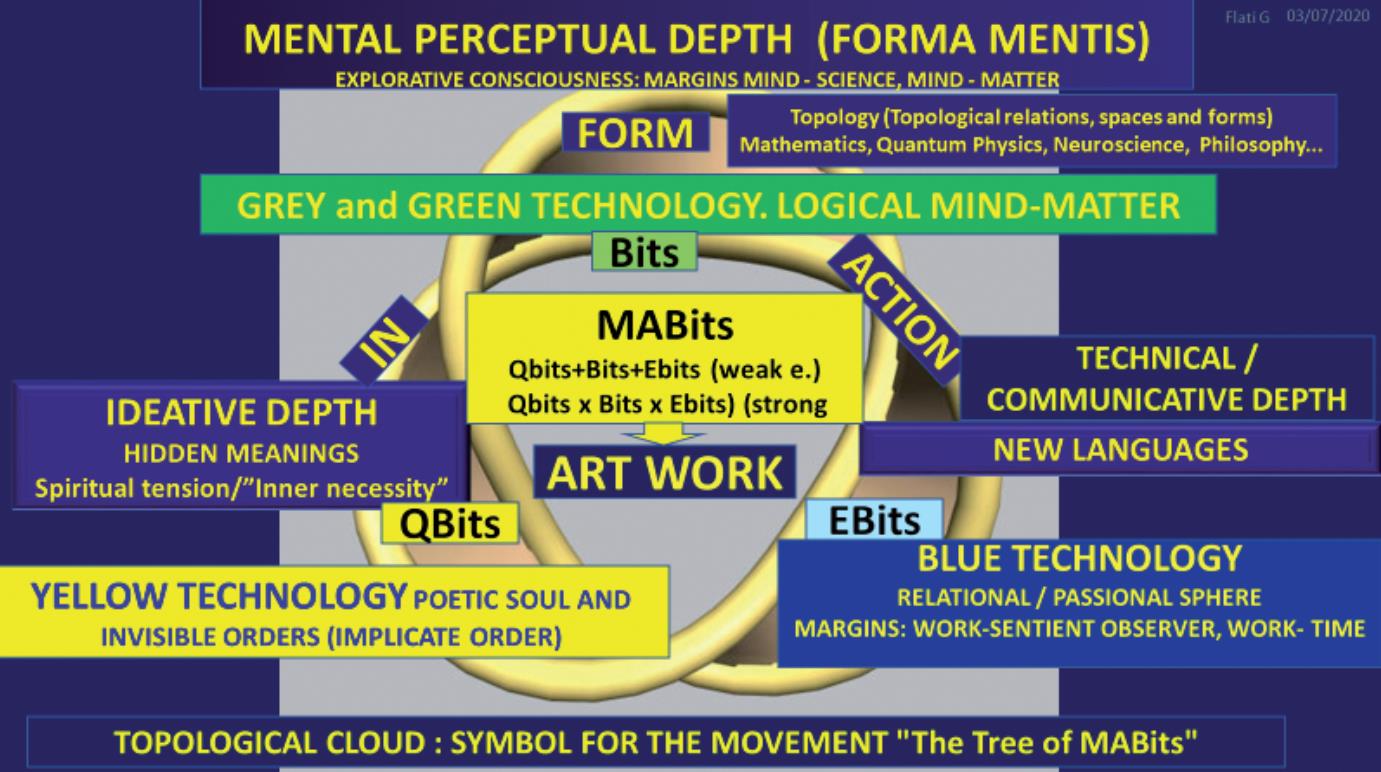
Figure 2. Synoptic scheme of creative process. The topological structure with “Trefoil Seifert knotted surface” is the metaphor of the Tree of Margins. It is a symbolic image and at the same time a concrete representation of the creative process. The three paths of the In–Form–Action are intertwined and knotted in the “multidimensional configurational” space. They are dynamically interconnected with each other as mediators between the external world (Reality independent of the mind: Cosmos and Microcosm,) and the work at the center of the creative process. This interconnection (Spiritual Mind, Logical Mind and Relational Passionate Mind) is a dynamic flow of informations resources (Qbits, Bits, Ebits). The creativity of the mind transforms them into Marginal Art Bits (MABits) thanks to the equation: 1) (strong) MABits = QBits x Bits x EBits or 2) (weak). MABits = QBits+ Bits + EBits. The roots of our tree are not schematized, because they are to be imagined as being aerial and invisible roots. Let’s imagine them as fractal processes, as filiform agglomerations sinking their offshoots (rolled, tangled and interacting) in the deep spaces of the various margins. These roots carry creative sap and in the form of Qbits, Bits and E Bits. The quality of the product of this whole process is directly proportional to the intrinsic value of the three domains of the creative MIND: SPIRITUAL (Ideation), LOGICAL (Scientific Forma Mentis), EMOTIONAL / RELATIONAL / EXPRESSIVE.
OPRA 2020
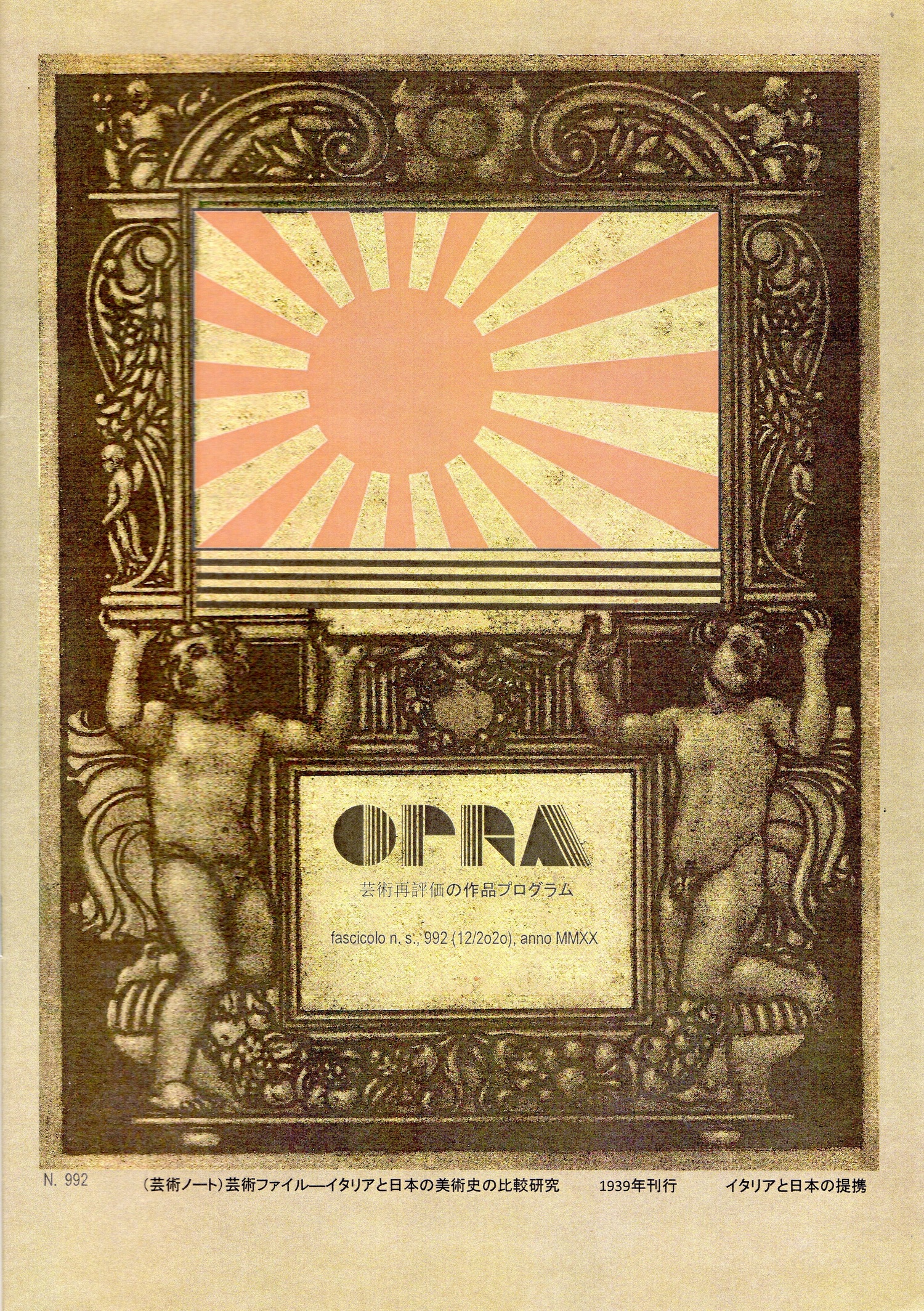
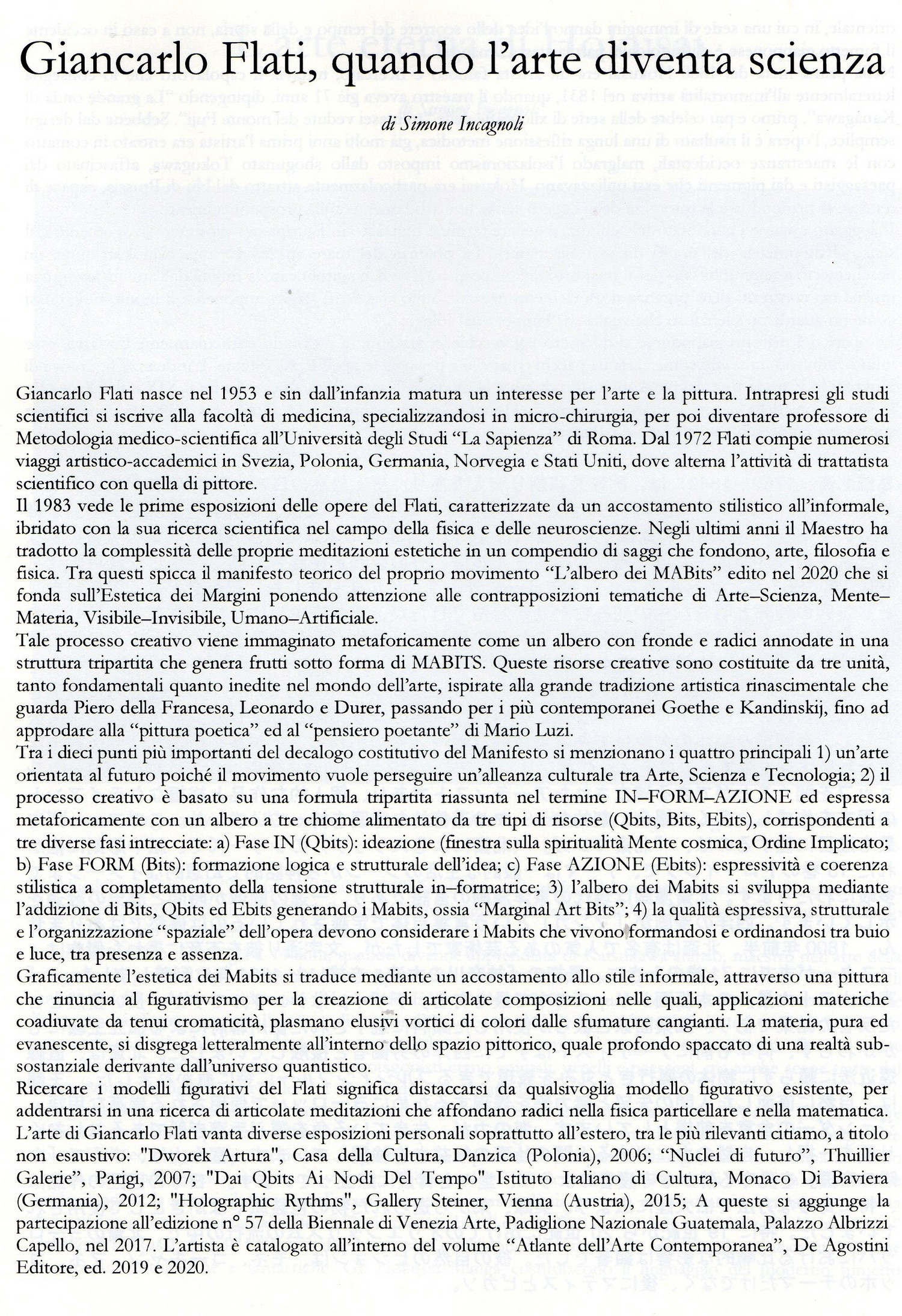
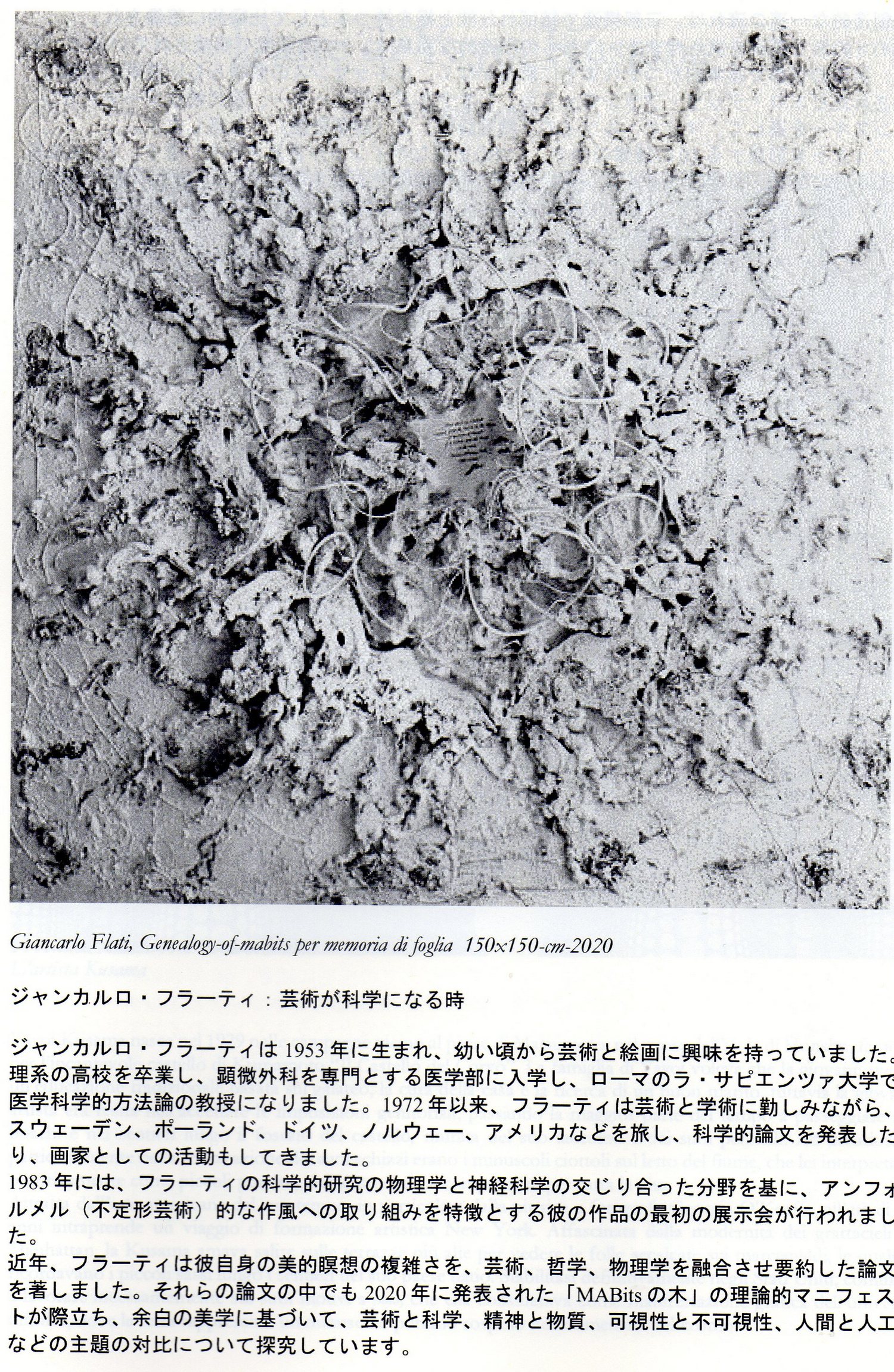
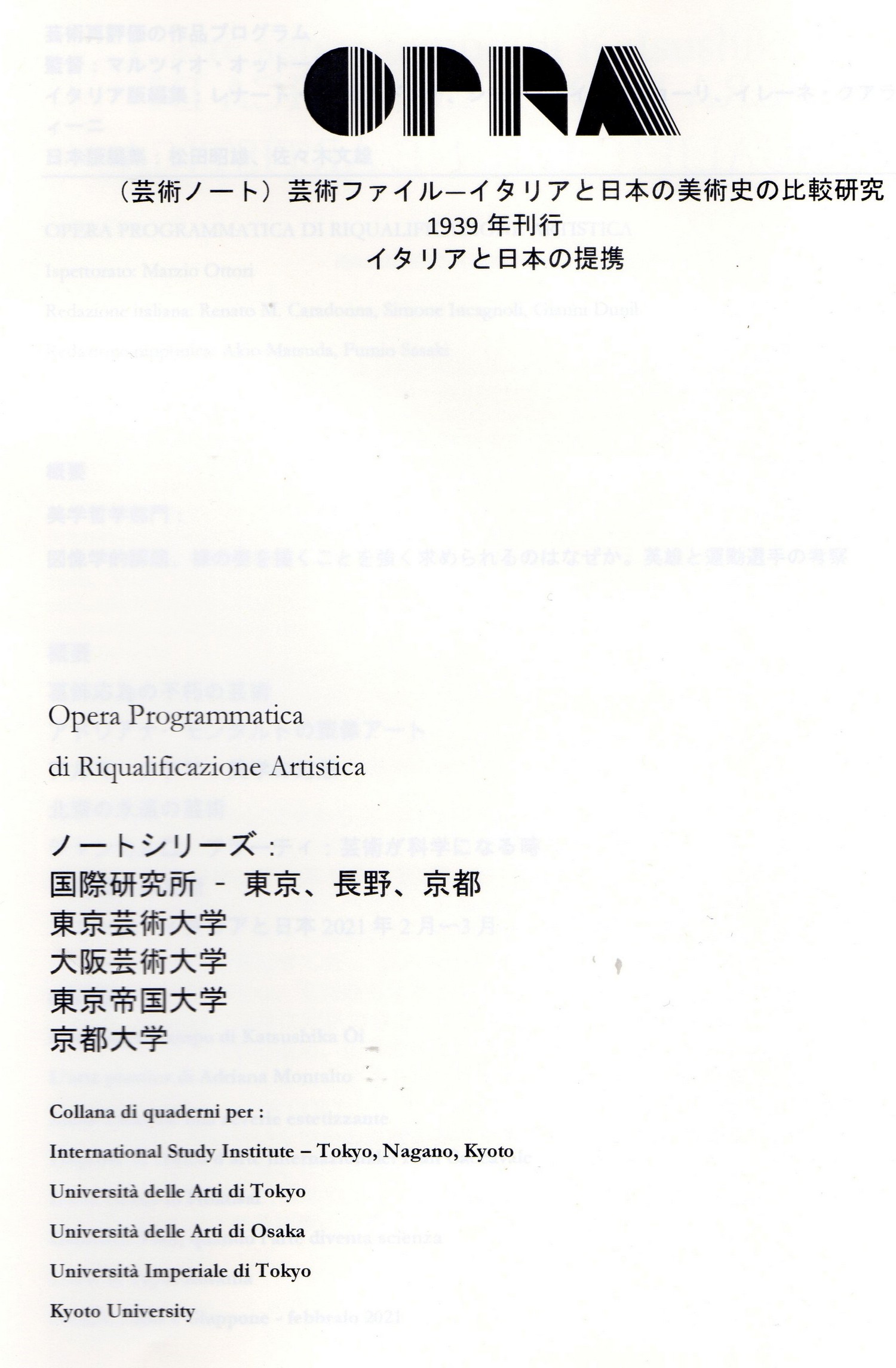
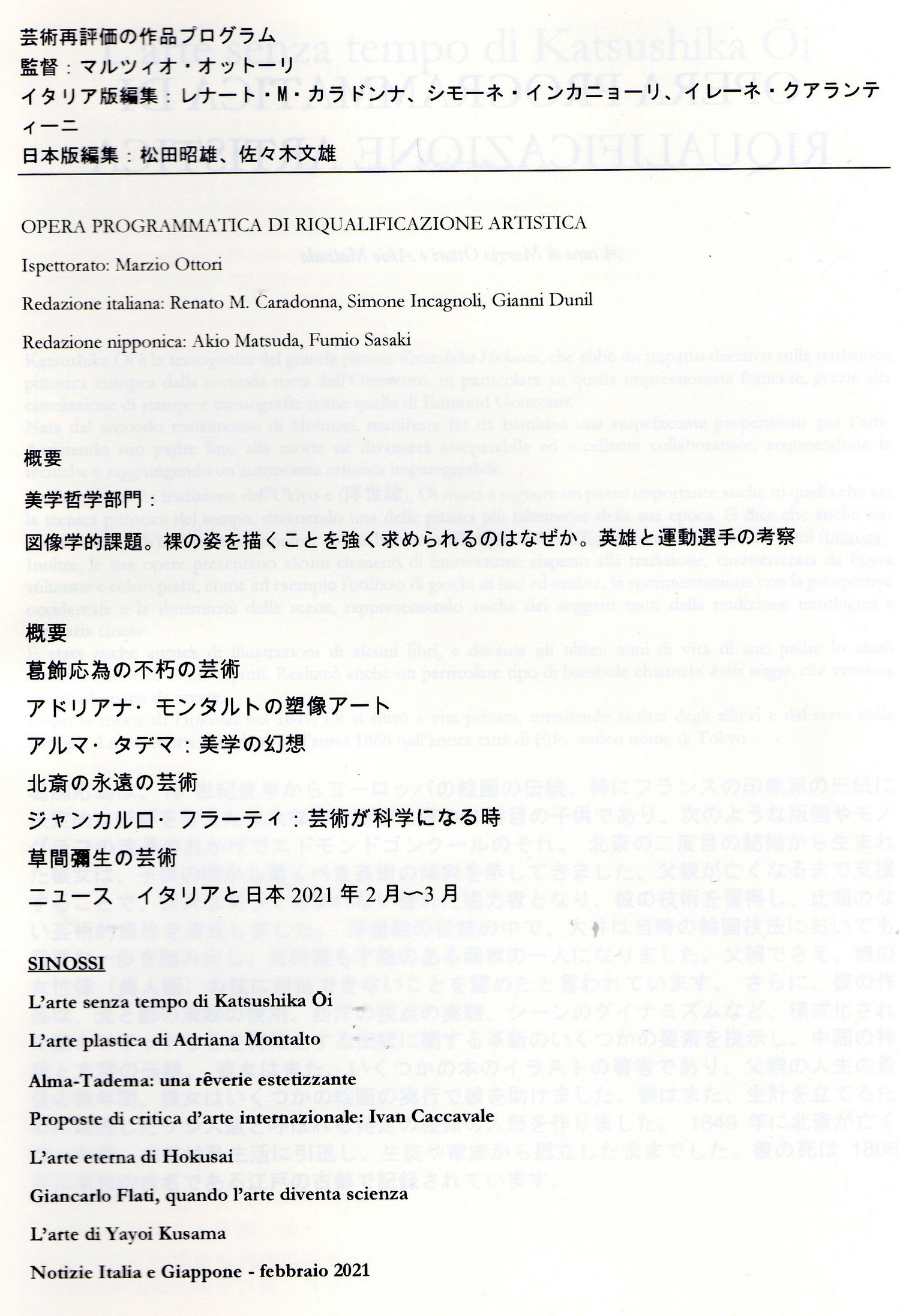
Atlante dell'Arte Contemporanea De Agostini 2021
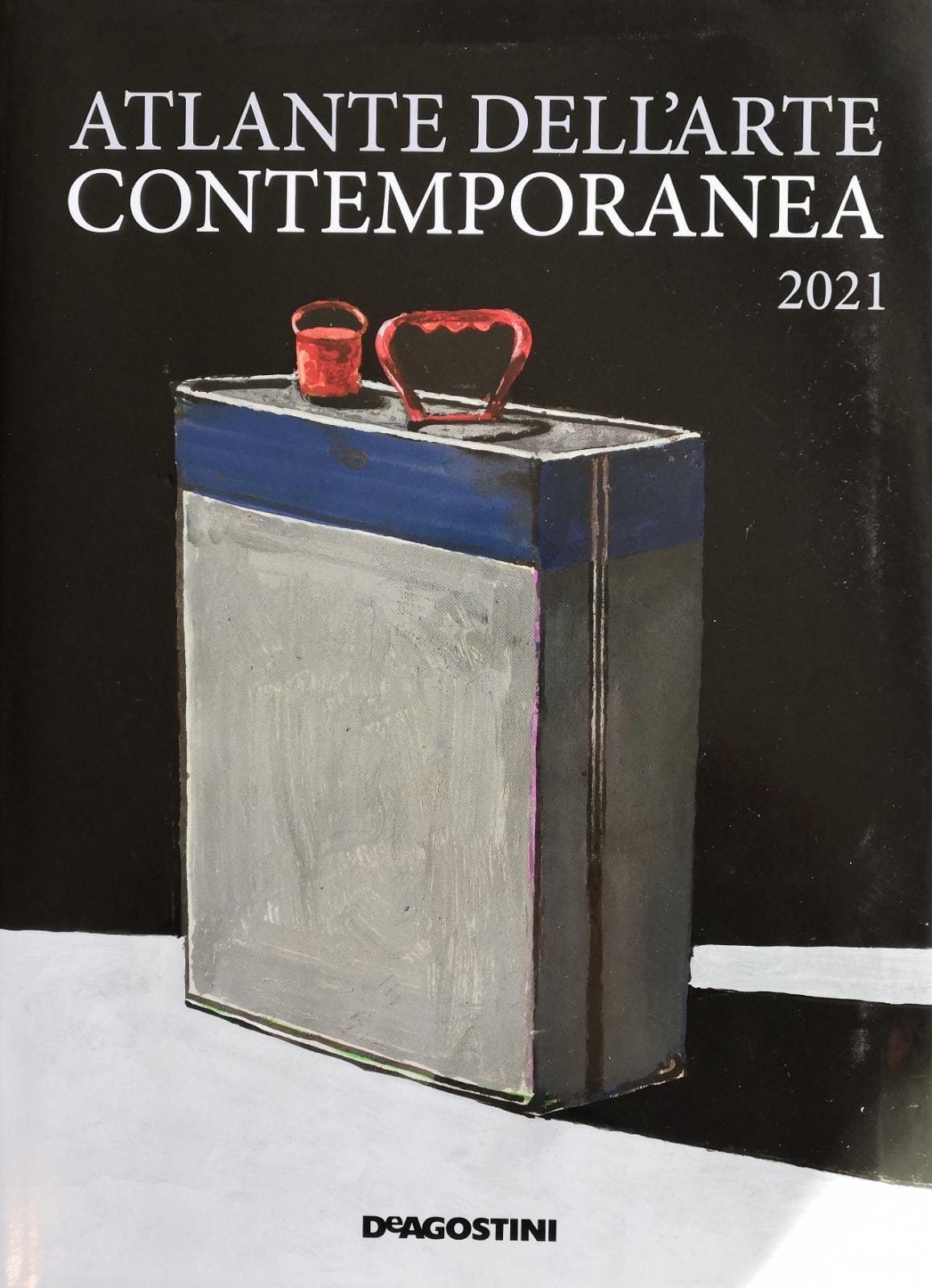
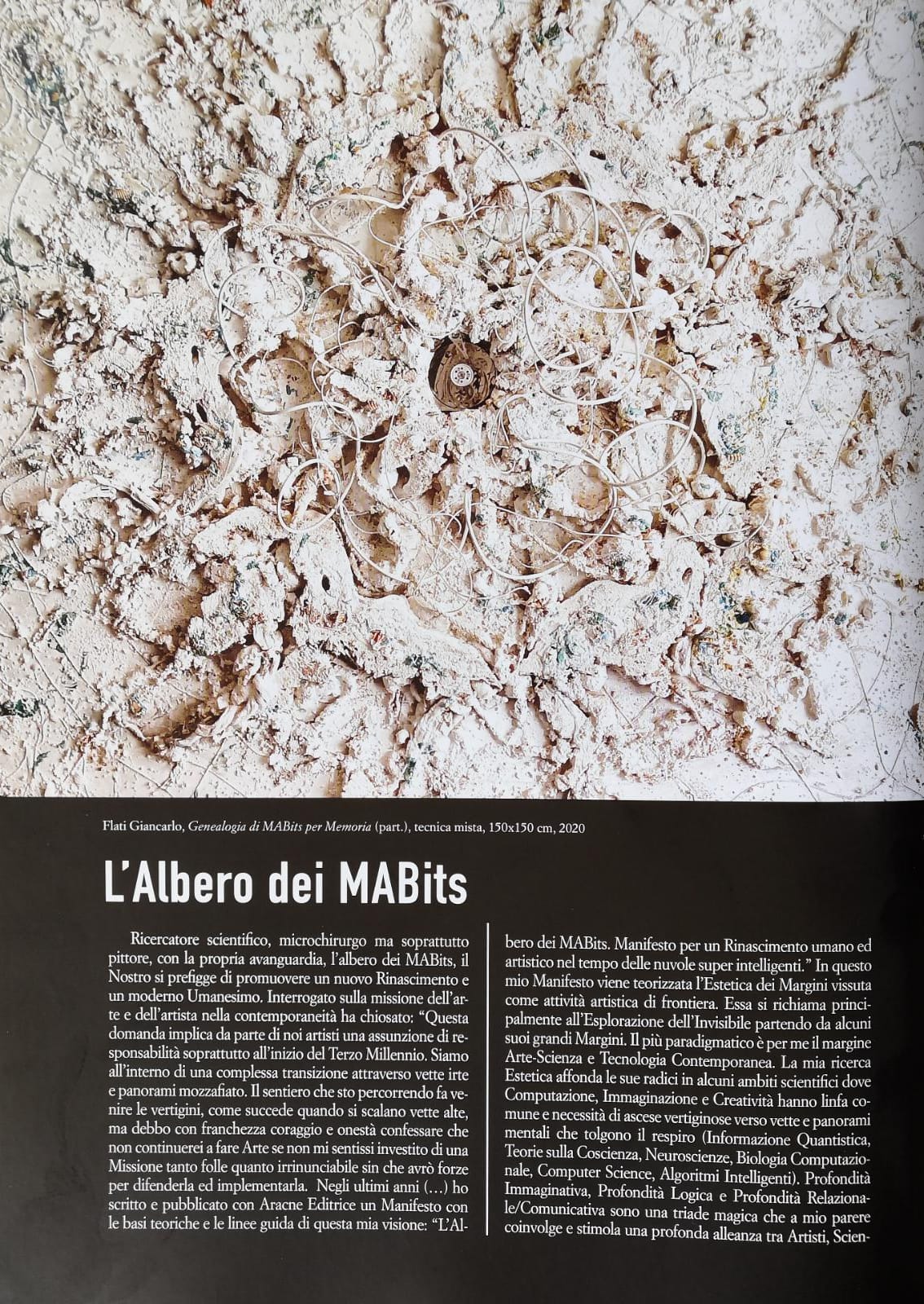
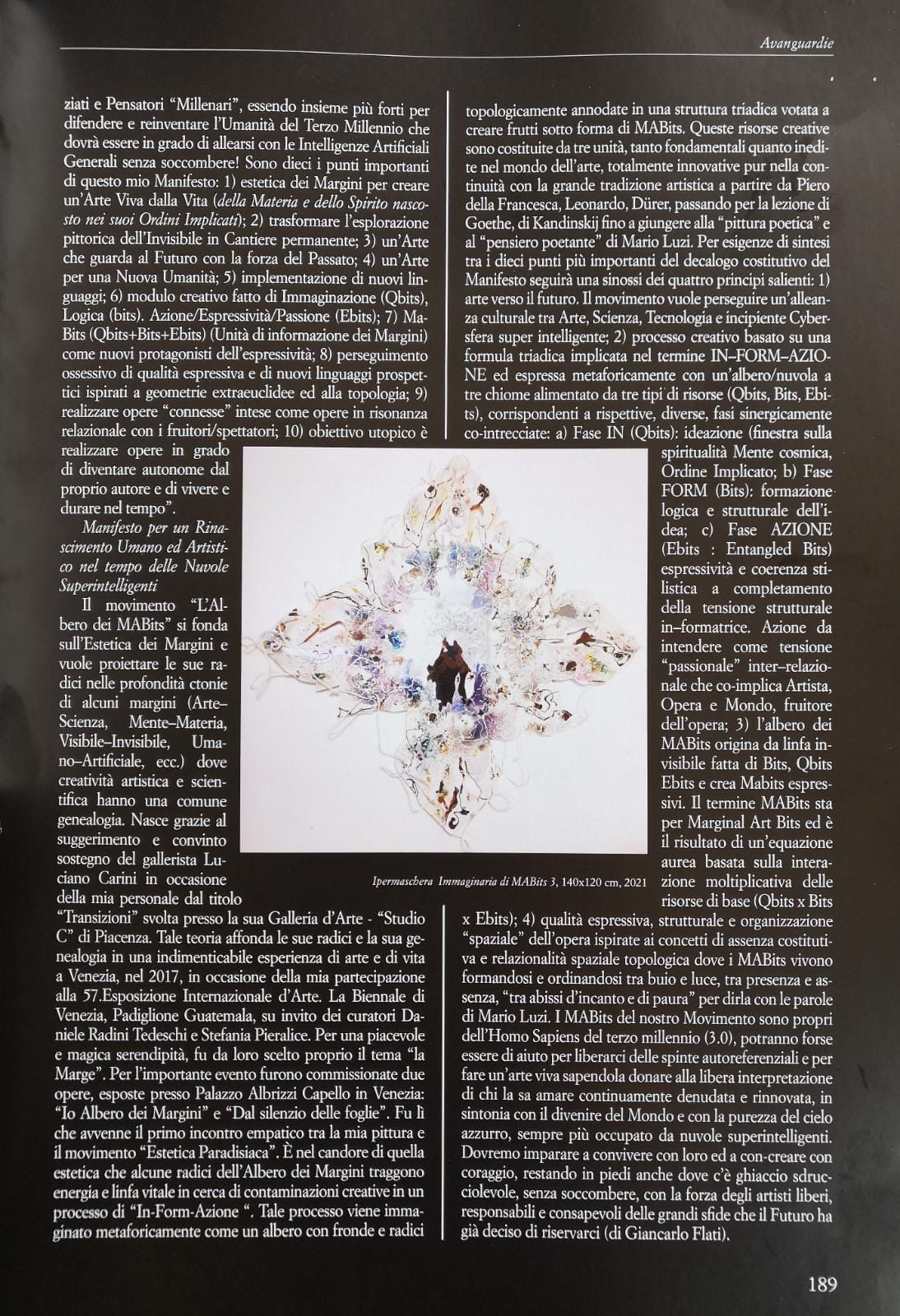
Cultura Identità - Metaverso, teconologia, astrazione - 18 Dicembre 2022
